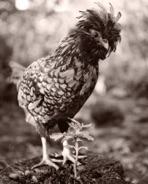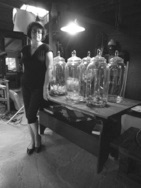all rights reserved Hope Sandrow copyright 2021

2006 ongoing

THEN
1891 - 1902
(above l,) William Merritt Chase at home/studio (1891-1902, map pin 4); (r) (possibly) Chase’s wife Alice feeding a flock of chickens Photographs by Albert Chittenden (1900) collection Hope Sandrow
(above) pictured in Sandrow’s open air studio Shinnecock Hills, Padovana Gold Lace Hen Cleo The Sky is Falling; (below) August 12, 2007; Hen Cleo roosting in Juniper Tree with pullets Katia, Rut, Sarandipity; cocks Galileo, Agenor, Alain born June 17


open air studio shinnecock hills is sited amongst ancestral lands where nomadic hunter-gatherers once roamed freely to and from Manhattan alongside Fowl, Fox, Deer, Bear. The impact of broken treaties and agreements enabled the Long Island Improvement Company’s transformation of a natural landscape stewarded by Shinnecock Nation (Note 1), subjects of Chase and and his Shinnecock Summer School of Painting students (1891 - 1902). To one of lands privately held as highly valued real estate intersected by roads, divided by ownership. Jane B. Colt’s gardens (Note 2) lost to an overgrown thicket of Rotundifolia shaded by towering Oaks and Pines. Vapor trails emitted from roaring transatlantic jets stream across skies shared with geese and herons traversing between Shinnecock and Peconic Bays. Gunshots (hunting) and the vroom of speed boats (pleasure) reverberate amidst noise and exhaust of passing cars and trucks (commuters). Ocean waves and train whistles heard in the blowing winds as in Colt’s time with cock-a doodling roosters, crow, songbirds along this Atlantic Flyway (Note 3).
Sandrow proposes open air studio shinnecock hills as a medium for creative engagement in a reconsideration of our relationship to nature and the natural world. The setting for the unfolding story of Padovana Shinnecock, and his descendants in her “living” art installation. Padovana (aka Padua aka Polverara aka Poland aka Polish) are classified as crested heritage chickens, descendants of Red Jungle Fowl traced back to Avian Dinosaurs 150 million years ago. Their existence noted in two marble statuettes, from 1st or 2nd century AD, in the Vatican Museum “Sala degli Animali” ("animal hall"). More recently titled “the royalty of poultry”, Padovanas the subject of 17th century painters d'Hondecoeter, Steen, Saftleven; Marie Antoinette kept a flock in concert with social practices at the time of returning “back to nature”; studied by naturalists including Charles Darwin (Note 4). Valued as egg layers, celebrated for intelligence and beauty: until now when Padovana are categorized as non-sitters “strictly for ornamental use” on the watch list of endangered fowls not having use for industrialized food (chicken and egg) practices.
From their first encounter, Sandrow and Shinnecock illustrate the central premise of Michael Pollan’s seminal book “The Botany of Desire”: forming a similarly reciprocal relationship. That evolved into art works, and installations shaped as habitat for the muse of her study and his descendants. They choose to remain (wings not clipped), laying eggs and foraging (hunting mosquito’s, ticks, beetles) that she proactively cares for daily, sunrise to sunset. The resulting challenges, from zoning laws to predators, and compromises (Sandrow leaving the loft/studio and artist community in beloved New York City for a commitment as artist in resident and flock keeper) becoming subjects. Presented in a series of art works, beginning with When Dreams Collide: Shinnecock: Life, Art and the Pursuit of Happiness that considers the “value” of artists and art; conserving open land, preserving ancestral hills, architecture and heritage chickens (Note 5).
The Flock’s birth rate illustrates the impact of climate changes on the developing embryo within their eggs.
Moments of daily life in her open air studio reveal the inner nature of things, framed for Sandrow to study. And for others to observe through the medium of cloud based networking (since 2007) via the on site livestream Happening Live spacetime. In which a dozen site specific installations framed by a dozen network cameras donated by Panasonic North America, livestream conditions faced by flora and fauna adapting to changes in climate (global effects) and environment (locally). Sandrow’s outreach beyond the art world:
Happening Live Now
June 10, 2007:
“Having been told by Experts that my Padovana or Padua Hens Cleo and Chloe were of a non setting breed: I was surprised to see Cleo doing just that. Approaching the 21 days chicks were expected to emerge from the egg’s shell, I’m creating this public art work Happening Live Now, utilizing a surveillance camera to transmit live images of Cleo setting on her eggs, for you, experts and others to observe along with me what happens next:
Join us (via surveillance camera) LIVE
in Cleo's Southampton (New York) nest as she sets on 11 eggs at:
hopesandrow.viewnetcam.com:5000
Although experts and breeders cite numerous documentation that Padovana’s or Paduans or Polish are non setting chickens, nonetheless, on May 28, Cleo followed her natural instinct to set on 11 eggs she and Chloe laid. Just as the literature describes, she sets herself in a trance while incubating her eggs for 21 days (what you will be watching on the surveillance camera). Play the part of "observer" in an artwork that aims to alter misconceptions of chickens by showing how those chickens that live"freely" can be freed of the bonds of commercial farm production that are a major contributor to global warming and fuel crisis.
Happening in real time, watch eggs mature, chicks hatch (approximately June 18th, 2007) and go off into the world with their "Mother" Hen Cleo.
Breeders practicing animal husbandry (selective breeding) choose a rooster and a hen to “mate” while isolated in a cage that benefits the breeders own advantage. The Hen’s eggs removed and placed inside incubators to hatch. Rather then allowing the Hens to select their mates based on the survival of the flock as their natural practice since their dinosaur ancestors. The chicks raised by human hand, the breeder, not by their nature to fly, roost in trees and forage with Mother Hens.
Was unexpectedly met with controversy by Breeders Club members:
June 10, 2007
Polish aka Padua aka Padovana are not normally setters. I have had a few to set, including one that would set until the chicks hatched, then kill them as soon as they come out of the eggs. If Cleo does this will your camera still be out there for all to see, including children?
Those folks are in business to make a profit. Without the profit angle of it, many folks who like to eat chicken and eggs, would not have any to eat. They are not in the business of making the hens happy. Using the computer to make these post use energy derived from fossil fuel also. What about that?
If I, and other exhibitors, had to follow your thoughts on incubation, the hobby would be dead in short time, and pure bred poultry would cease to exist.
And shut down:
June 22, 2007

p.s.The "happening live now: Cleo setting on 11 eggs" will be deleted soon so if you haven't read it, do it soon. Let's all not add to it and let the flames die down.....
Note 1: The Guardian, July 2010: Native American tribe reclaims slice of the Hamptons after court victoryHistorically – and indeed pretty much since Europeans first arrived in the area in the 1600s – the Shinnecock have been on the retreat. They lost land steadily as more and more Europeans began to farm their traditional territory, eventually leading to an agreement in 1703 that saw them confined to a broad swath of land around Southampton under a 1,000-year lease. However, in 1859 the pressure of development saw that deal scrapped by the settlers and the Shinnecock reduced to their current tiny holding.
Note 2: The Jane Borrowe Colt Summer “Cottage” (1891) burned to the ground (1951)... see what “remains”....what “lays bare”.
Note 3: Atlantic Flyway once route for 500 species of birds.
Note 4: Charles Darwin: "I have examined fourteen skulls of Polish (aka Padovana) and other crested breeds".
Note 5: February 2 2021 publication “The Economics of Biodiversity: The Dasgupta Review “


(above, l) Hope Sandrow, Ulf Skogsbergh, Shinnecock photographed by Nicole Bengiveno (July 15, 2009), New York Times “Feathering Her Nest” by Penelope Green Artist and subject all rights reserved Nicole Bengiveno; (r) Hope Sandrow inside her home/studio by Andrea Grover 2012
The ensuing dialogue connecting to conversations outside the installation’s boundaries: timely issues from scientific (i.e. chickens reclassified as avian dinosaurs); evolution (Darwin’s The Variation Of Animals and Plants Under Domestication; Chapter VII Fowls); to cultural (a chicken embryo looks identical to Ambrym Peoples Slit Gongs and Grade Figures and the resemblance of the Padovana Shinnecock feathered crest to North American “Indian” Eastern Woodland headdress regalia); to industrial farming (Padovana an ancient heritage breed not genetically modified). Amidst documentation (_Findings, //cache), studies and artworks ranging from temporary projects, sculptures to live performances following Sandrow’s Chance Encounter.
A “world” redrawn, reinvented daily in the cyclical nature of the natural world: When Dreams Collide, Observational Findings Untitled (lay bare), (Re)Collecting an American’s Dream: Gissa Bu; happening live, Observational Findings, Coop LeWitt: (re)constructing Sol LeWitt, The Sky is Falling, Observational Findings Drawn in Dirt, Sky(gaze) within a Cube, Observational Findings Gallus Gallus, Portrait of a Chicken as An Egg Within A Golden Rectangle, Portrait of a Chicken as an Egg (Candled) Within A Golden Rectangle, The Sky is Falling (Too),(Re)collecting an Artists Dream.
Sandrow’s focus continues to reveal new understandings and relationships about longstanding issues central to her practice: climate change, social inequities, race and gender discrimination, violence against women, the environment, history, development. And food equality: an estimated 31,440 (as of January 5, 2022) eggs have been laid during the projects’ trajectory. Those not set on by Hen’s for breeding were consumed by Sandrow and Skogsbergh, shared with family, friends, colleagues, neighbors, The Retreat and Shinnecock Indian Nation Food Pantry.
In addition to the art works that comprise “home” for an endangered breed of chicken through the transformation of her backyard to “open air studio”, other outcomes include: 1) preserved public access to a bay beach pictured in Chase’s oil painting (1892) of his family “At the Seaside”; 2) recognization by New York State Preservation League "Seven to Save Endangered Properties" and subsequent acquisition (2007) of ten acres of Shinnecock Hills ancestral lands; 3) A series of public performances along the road that Padovana Shinnecock crossed engaged passersby, often stranded in traffic, inspired by a call and response exchange of cock-a-doodle- doos that answered the riddle, “Why did the chicken cross the road?” ; 4) The personal and public practices in open air studio were translated to the site of the new Parrish Art Museum in a commissioned new work Genius Loci to inaugurate Curator Andrea Grover’s Platform Program (November 2013–March 2014); 5) With Shinnecock Neighbors, she challenged a proposed zoning change of ancestral lands by the Town Board, from hearings to the courts (a judge’s ruling noted her work). And created the freely accessed public art project Sketches of Local History as a proactive public forum for residents of all ages to “imagine tomorrow” in sketches of the Canal’s shores; 6) Founding the first Town of Southampton Arts and Culture Committee (April 2017) which she chairs: “my medium to engage colleagues and east end residents in creating the cultural landscape we want to live in”; 7) Women’s Study(room) in the Cottage (post covid, in process) will host a lending library, an artist residency inaugurated with the group exhibition (Re)collecting an Artists Dream.
Making art that reflects life experiences within the frame of our natural world has been Sandrow’s medium for life since a child. “Why, Sandrow says, beginning at an early age, assault on my body linked to that on earth, air and water.”


